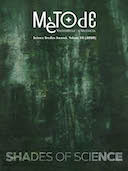Memory written on bones: From 'funus' rites to the osteobiography of Valentia
DOI:
https://doi.org/10.7203/metode.10.13595Keywords:
funerary archaeology, palaeopathology, paleo diet, isotopes, Valentia Abstract
Abstract
The Roman necropolis in Carrer Quart in Valencia (Spain) is the city’s oldest known cemetery, dating from between the second century BC and third century AD. Based on its archaeological and bioanthropological analysis, we examine various hitherto unknown issues from an interdisciplinary perspective. By using isotopic archaeochemistry, various aspects, such as those concerning funerary practices, social stratification, paleodemography, quality of life, and the impact of disease, food, and the subsistence economy, as well as population mobility, have enriched our knowledge of the landscape of the old town. Science and memory converge in Valentia through the culture and traditions documented in the funerary ritual (funus valentiae).
 Downloads
Downloads
 References
References
García-Prósper, E. (2016). Los ritos funerarios de la necrópolis romana de la calle Quart de Valencia (siglos II a. C-III d. C). Valencia: Universitat de València, Departament de Prehistòria i Arqueologia.
García-Prósper, E., & Polo-Cerdá, M. (2016). Los primeros pobladores de Valentia. Un proyecto transversal de ritual funerario y bioantropología. Arqueología Somos Todos, 5, 18–20.
García-Prósper, E., Polo-Cerdá, M., & Guérin, P. (2003). Rituales funerarios ibéricos en la necrópolis fundacional de Valentia. Anales de Arqueología Cordobesa, 13-14, 279–310.
García-Prósper, E., Polo-Cerdá, M., Romero, A., & Iborra, P. (2010). Rituales alimentarios y economía de subsistencia en las tumbas de cámara de la necrópolis romana de la calle Quart de Valentia (ss. II a. C - III d. C). Saguntum extra, 9, 233–242.
Macdonell, W. R. (1913). On the expectation of life in Ancient Rome, and in the provinces of Hispania and Lusitania, and Africa. Biometrika, 9(3-4), 366–380. doi: 10.2307/2331898
Pena, M. J. (2002). Problemas históricos en torno a la fundación de Valentia. In J. L. Jiménez, & A. Ribera (Coords.), Valencia y las primeras ciudades romanas de Hispania (pp. 267–278). Valencia: Ayuntamiento de Valencia.
Polo-Cerdá, M. (2017). Paleobiología humana de la fundación romana de Valencia. Alicante: Biblioteca Virtual Miguel de Cervantes.
Polo-Cerdá, M., & García-Prósper, E. (2002). Ritual, violencia y enfermedad. Los enterramientos en decúbito prono de la necrópolis fundacional de Valentia. Saguntum (Papeles del Laboratorio de Arqueología de Valencia), 34, 137–148. doi: 10.7203/SAGVNTVM..1902
Polo-Cerdá, M., García-Prósper, E., Guérin, P., & Villalaín, J. D. (2004). La fundación de Valentia y sus primeros pobladores. Primeras evidencias osteoarqueológicas de tuberculosis en Hispania. Zona Arqueológica (Miscelánea en homenaje a Emiliano Aguirre), 4(3), 292–305.
Ribera, A. (1998). La fundació de València. La ciutat a l’època romanorepublicana (segles II-I A. de C.). Valencia: Edicions Alfons el Magnànim.
Ribera, A. (2009). La fundación de Valentia: Un apéndice de Italia y Campania en la Hispania del siglo II a. C. Oebalus. Studi sulla Campania nell’Antichità, 4, 41–77.
Ribera, A., & Jiménez, J. L. (2014). La imagen urbana de Valentia. In M. Olcina (Ed.), Ciudades romanas valencianas (pp. 143–165). Alicante: MARQ.
Thillaud, P. L., & Charon P. (1994). Lésions ostéo-archéologiques. Recueil et identification. Sceaux: Kronos B. Y. éditions.
Downloads
Published
How to Cite
-
Abstract1182
-
PDF738
Issue
Section
License
![]()
All the documents in the OJS platform are open access and property of their respective authors.
Authors publishing in the journal agree to the following terms:
- Authors keep the rights and guarantee Metode Science Studies Journal the right to be the first publication of the document, licensed under a Creative Commons Attribution-NonCommercial-NoDerivatives 4.0 International License that allows others to share the work with an acknowledgement of authorship and publication in the journal.
- Authors are allowed and encouraged to spread their work through electronic means using personal or institutional websites (institutional open archives, personal websites or professional and academic networks profiles) once the text has been published.





